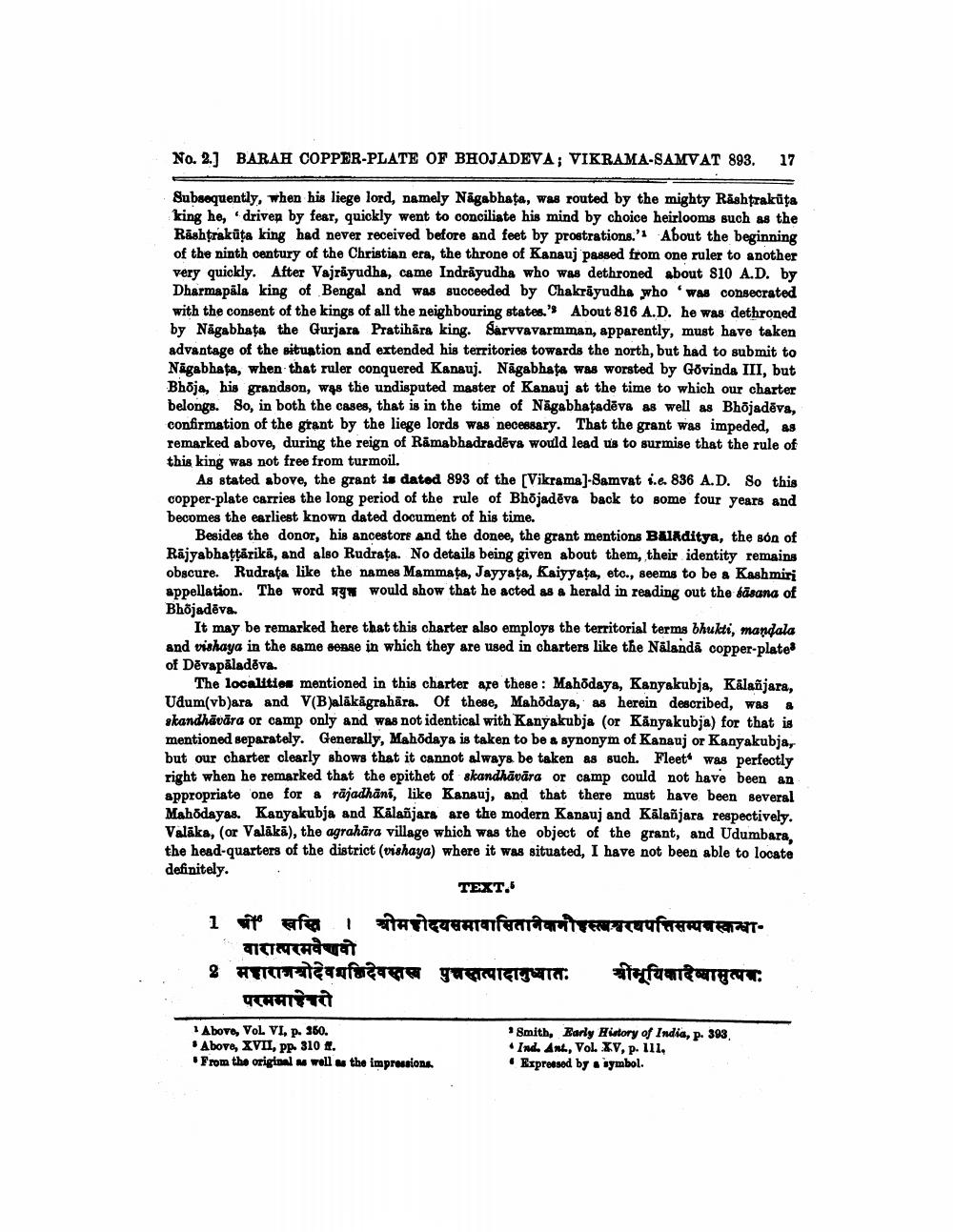________________
No. 2.) BARAH COPPER-PLATE OF BHOJADEVA; VIKRAMA-SAMVAT 893.
17
Subsequently, when his liege lord, namely Nagabhata, was routed by the mighty Rashtrakūta king he, driven by fear, quickly went to conciliate his mind by choice heirlooms such as the Rashtrakūta king had never received before and feet by prostrations.'' About the beginning of the ninth century of the Christian era, the throne of Kanauj passed from one ruler to another very quickly. After Vajriyudha, came Indrāyudhs who was dethroned about 810 A.D. by Dharmapäls king of Bengal and was succeeded by Chakriyudha who was consecrated with the consent of the kings of all the neighbouring states.'s About 816 A.D. he was dethroned by Nagabhata the Gurjara Pratihāra king. Sarvvavarmman, apparently, must have taken advantage of the situation and extended his territories towards the north, but had to submit to Nigabhata, when that ruler conquered Kanauj. Nagabhata was worsted by Govinda III, but Bhoja, his grandson, W48 the undisputed master of Kanauj at the time to which our charter belongs. So, in both the cases, that is in the time of Nagabhatadēva as well as Bhöjadova, confirmation of the grant by the liege lords was necessary. That the grant was impeded, as remarked above, during the reign of Råmabhadradeva would lead us to surmise that the rule of this king was not free from turmoil.
As stated above, the grant is datod 893 of the (Vikrama) Samvat i.e. 836 A.D. So this copper-plate carries the long period of the rule of Bhöjadēva back to some four years and becomes the earliest known dated document of his time.
Besides the donor, his ancestors and the donee, the grant mentions BalAditya, the son of Rajyabhattarikā, and also Rudrata. No details being given about them, their identity remains obscure. Rudrata like the names Mammata, Jayyata, Kaiyyata, etc., seems to be a Kashmiri appellation. The word we would show that he acted as a herald in reading out the täsana of Bhöjadēva.
It may be remarked here that this charter also employs the territorial terms bhukti, mandala and vishaya in the same sense in which they are used in charters like the Nålandā copper-plates of Dēvapāladēva.
The localities mentioned in this charter are these : Mahodaya, Kanyakubja, Kalañjara, Udum(vb)ara and V(B)alākāgrahāra. Of these, Mahodaya, as herein described, was & skandhāvāra or camp only and was not identical with Kanyakubja (or Känyakubja) for that is mentioned separately. Generally, Mahodaya is taken to be a synonym of Kanauj or Kanyakubja, but our charter clearly shows that it cannot always be taken as such. Fleet was perfectly right when he remarked that the epithet of skandhāvāra or camp could not have been an appropriate one for & rājadhāni, like Kanauj, and that there must have been several Mahodayas. Kanyakubja and Kālañjara are the modern Kanauj and Kālañjara respectively. Valaka, (or Valākā), the agrahāra village which was the object of the grant, and Udumbara, the head-quarters of the district (vishaya) where it was situated, I have not been able to locate definitely.
TEXT.
1ौं खसि । श्रीमहोदयसमावासितानकनौहत्त्वावरवपत्तिसम्पनस्कन्धा.
वारात्परमवैशवो १ महारानवोदेवशष्टिदेवस्तस्य पुनस्तत्वादानुष्यात. श्रीभूयिकादेव्यामुत्पनः
परममाहेरी
* Abovo, VoL VI. p. 360. . Above, XVII, pp. 310 4. From the original M wall
* Smith, Early History of India, p. 393 • Ind. Anb, Vol. XV, p. 111, • Expressed by a symbol.
the impressions




